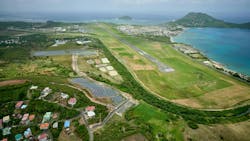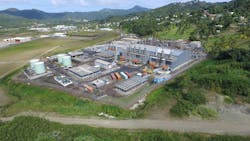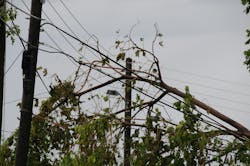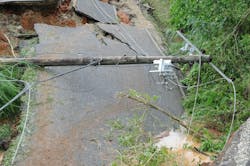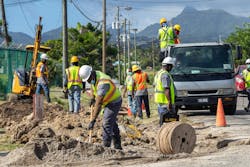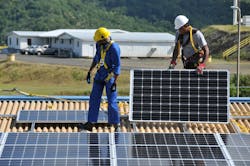Winds of Change for St. Lucia’s Electric Grid
Nestled midway through the Lesser Antilles — the emerald arc of the Caribbean islands — the island nation of St. Lucia is situated farther out to sea than any neighboring island but Barbados. It is located squarely within Hurricane Alley, the belt of warm water that spans the Atlantic between the Tropic of Cancer and the Equator. Within this belt, hurricanes spawn, gather strength, and barrel westward across the Caribbean and onward.
While often spared by the many storms that travel just to the north of the island, St. Lucia nonetheless has suffered several catastrophic storms over the last four decades. They have included Hurricane Allen (1980), which made nearly 10,000 people homeless; Hurricane Debbie (1994), which hit St. Lucia as a tropical storm and destroyed between 60% and 80% of the island’s crops; Hurricane Tomas (2010), which killed 14 people despite its less dangerous Category 1 storm classification; and the Christmas Eve Trough of 2013, which dumped 10 inches (254 mm) of rain on the island overnight and left several communities physically isolated from the rest of the island for several weeks. Hurricane Elsa, the first hurricane of 2021, tore across the Lesser Antilles, killing one person in St. Lucia and destroying 80% of its crops.
Such storms show every sign of continuing. St. Lucia is now one of many island nations drawing attention in world forums to the fact that large storms are becoming increasingly frequent, more powerful, and deadlier because of global climate change and the warming of the oceans. St. Lucia Electricity Services Ltd. (LUCELEC) is the country’s vertically integrated electric utility and sole provider of power to the island’s 180,000 residents and 300,000 annual tourists. It faces a challenge familiar to many electric utilities, but with greater urgency and higher stakes: how best to strengthen its T&D systems to withstand stronger, more dangerous, and more frequent storms, and how best to allocate resources to ensure value for money.
These urgent initiatives take place in the context of broader ongoing policy and strategy questions at the national level, such as how best to decrease reliance on imported diesel fuel for generation, integrate privately managed sources of generation, and determine what role renewable energy (including wind, solar and geothermal assets) will play in the generation portfolio and broader economic, consumer and market initiatives that support commercial, residential and industrial markets in St. Lucia.
Resilience and Reliability
Established in 1964, LUCELEC has provided power to the island’s growing economy for nearly 60 years, helping to make possible the country’s incredible economic growth led by tourism and agriculture. The country is 100% electrified, with 72,000 customers. LUCELEC’s generation portfolio consists of 86.2 MW of generation, a 66-kV transmission backbone and seven distribution substations that supply power to 32 distribution feeders running at 11 kV. The T&D systems are largely overhead, with some key segments recently placed underground. Utility poles are a mix of wood and reinforced concrete poles.
In late 2022, LUCELEC worked with POWER Engineers Inc. and its partner K&M Advisors LLC to establish risk metrics and identify a portfolio of ranked projects with the potential to improve resiliency and reliability in the face of strengthening storms.
Grid reliability and grid resilience are related but different. Grid reliability is clearly understood and measured, as established by IEEE 1366, the well-known standard for power distribution reliability indices used by the electric power industry for decades. However, building consensus on a precise definition and metric for resiliency has been an industry challenge for many years that may not yet be fully resolved. In general, resiliency is specified in terms of prevention, recovery and survivability. Many definitions conflate resilience with reliability or provide notional directives while failing to establish metrics.
J.D. Taft of the Pacific Northwest National Laboratory stated in a paper, the Electric Grid Resilience and Reliability for Grid Architecture: “Reliability measures are not useful for quantifying resilience. Resilience is in large part about what does not happen. Grid resilience is the ability to avoid or withstand grid stress events without suffering operational compromise or to adapt to and compensate for the resultant strains so as to minimize compromise via graceful degradation.”
Reviewing the Opportunities
LUCELEC and POWER Engineers began their collaboration by reviewing the nature and frequency of previous outages, characterizing the technical, commercial and economic consequences of different outages and damages to grid infrastructure. Team leads from the utility’s engineering, construction, customer care, distribution grid planning and generation groups provided data and insights as well as recommended project priorities worth considering. Given the many technical and climatic challenges the utility faces, two factors bode well for LUCELEC: It is financially self-sustaining and profitable, and its technical teams are highly competent with excellent firsthand experience.
One challenge confronting not only St. Lucia but many electric utilities worldwide: The majority of the world’s distribution systems were built decades ago. The construction standards were less stringent than today’s standards and developed in the context of smaller, less-frequent and weaker storms. Like the rest of the Caribbean, St. Lucia finds itself needing to establish improved construction standards that correspond to Category 5 hurricane wind loads. This has important economic consequences for utilities and their customers, as reinforced utility poles can mean billions of dollars in investment.
LUCELEC and POWER looked at reinforcing key segments of the utility’s grid, including feeders supporting key customers, important segments of the cross-island transmission backbone and distribution lines that had shown proclivity to damage in previous storm events. The teams examined not just material design requirements but also improvements to foundation design to reduce vulnerability of utility poles during landslide events stemming from heavy rain. Having well-developed construction, operations and maintenance standards that are reviewed and updated regularly is essential in helping a utility provide resilient service to its customers during these types of events.
POWER and LUCELEC then reviewed the existing maintenance programs in place. Vegetation management is at the core of every electric utility’s success. Trees, branches, and debris can all be blown onto lines during storm events, causing short circuits, breaking insulators, and simply downing lines. While LUCELEC records do show tree branches and fallen trees continue to cause challenges, the team’s joint review of the maintenance being undertaken on a continuous basis revealed LUCELEC had a maintenance and vegetation management program in place sufficient to meet the needs of the utility.
Identifying Easy Wins
The review of maintenance and inspection led to an interesting opportunity to make recommendations for pole inspection. Thorough inspection of distribution poles is an arduous, expensive and time-consuming task that challenges even large utilities. The challenge is greater in tropical nations like St. Lucia, where the humid, maritime climate means faster and more aggressive degradation of untreated wood due to humidity, rot, and wood-boring or consuming insects like termites.
Drone technology is increasingly a viable and cost-effective solution here, and numerous commercial providers now offer comprehensive pole inspection services. For example, POWER Engineers has partnered with Buzz Solutions, which offers a combination of drone-based imaging and inspection combined with artificial intelligence (AI) software trained to identify damage, weakness or anomalies to grid hardware. POWER recommended drone inspection providers whose equipment also provides infrared (IR) inspection, which can recognize hot spots, damaged insulators, and anomalies in conductor and mounting hardware invisible to the naked eye.
Drone technology is increasingly cost effective and, when faced with the risk of prolonged outages to key customers, provides excellent value for the money. For island economies reliant on tourist income, prolonged electrical outages affecting the hotel industry can have reputational consequences that negatively impact the tourism economy overall.
Together, POWER and LUCELEC identified another easy win for the utility, one that could cost less than expected. Like many electric utilities, LUCELEC finds its utility poles used by several other third parties, including communications providers. In more densely populated areas, the number of third-party attachments on LUCELEC-owned infrastructure can be significant. Like utilities around the world, LUCELEC found its guidelines were not always followed to the letter, leading to skewed guy wires, awkward angles and other anomalies — resulting in stressed utility poles.
During a large-scale power outage event, customers are more concerned with when will the power be restored rather than the root cause of why the pole failed. It is typically up to the electric utility to ensure that attachments to their infrastructure are executed in a safe manner that does not cause undue stress on that infrastructure.
Fortunately, enforcing one’s own rules is practically free, relative to other initiatives. However, it does require a significant public communication, outreach and stakeholder engagement program. Importantly, getting third-party attachments to comply must happen before each hurricane season passes over.
Starting with the Basics
POWER and LUCELEC reviewed several other project opportunities — some more costly than others — such as relocating substations, improving the sectionalization of the grid topology and several options for renewable energy. These are the kinds of analyses electric utilities worldwide find themselves studying. In preparing for strong storms, it is tempting to focus immediately on the big-ticket upgrades. These require large investments, procurement, engineering design and construction oversight. Many of them are timely and necessary.
Ensuring the grid provides alternate routes to key population centers is invaluable but may require large and costly investments in transmission towers, transformers and switchgear. Of lower cost but still high value is a more extensive use of auto-reclosers and a supervisory control and data acquisition system that reports faults and enables utility management teams to react during a storm.
However, grid resilience and reliability can often be accomplished simply by starting with the basics: An effective operation and maintenance plan, for example, should be every utility’s first step. Regular inspection of assets should be the second. Over the longer haul, building to the more stringent construction standards for stronger storms is essential.
Keeping electric power flowing to consumers is more necessary than ever in the modern world. As LUCELEC can attest, getting the fundamentals in place before a storm hits is an important part of delivering value to the thousands of consumers who depend on a utility.
Randall Wood is a senior project manager at POWER Engineers in its Government Services division. He has led power sector and infrastructure projects worldwide for nearly thirty years, and currently oversees POWER’s assignments in Latin America, Asia, Africa and the Caribbean.
Mike Allison is a senior project engineer at POWER Engineers in its Power Delivery division. Prior to joining POWER, Allison spent over thirty years with municipal utilizes in multiple roles, ranging from construction, engineering, operations and management.
For More Information
K&M Advisors | www.km-advisorsllc.com
Buzz Solutions | www.buzzsolutions.co
POWER Engineers | www.powereng.com
About the Author
Randall Wood
Randall Wood is a senior project manager at POWER Engineers in its Government Services division. He has led power sector and infrastructure projects worldwide for nearly thirty years, and currently oversees POWER’s assignments in Latin America, Asia, Africa and the Caribbean.
Mike Allison
Mike Allison is a senior project engineer at POWER Engineers in its Power Delivery division. Prior to joining POWER, Allison spent over thirty years with municipal utilizes in multiple roles, ranging from construction, engineering, operations and management.
